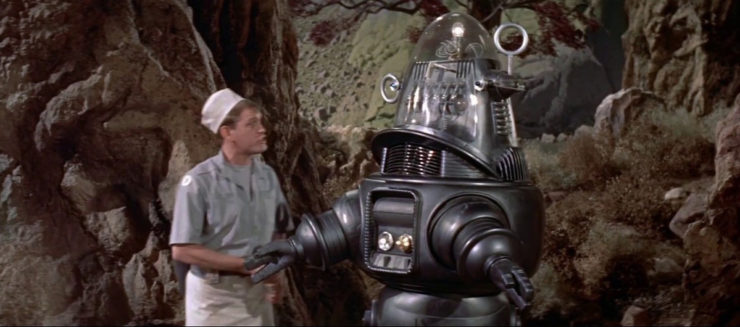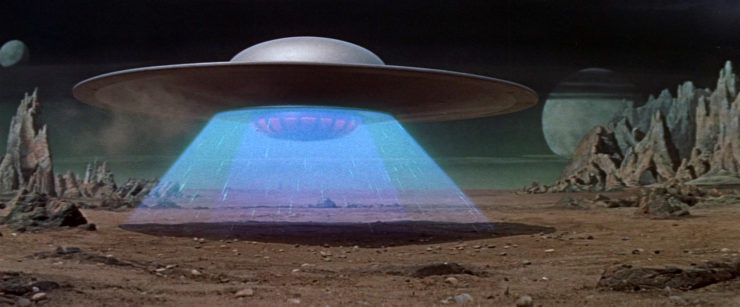Stop me if you’ve heard this before: A United Planets starship manned (we’ll get back to that) by an elite crew, on a multi-year mission at the borders of explored space, arrives at a seemingly desolate planet. They very quickly discover the planet is not quite as desolate as it seems; there’s something there that may endanger the ship.
Sounds like an episode of the week for Paramount’s beloved SF television franchise. Nope! It’s…
Forbidden Planet
Written by Cyril Hume (story by Irving Block & Allen Adler)
Directed by Fred M. Wilcox
Produced by Nicholas Nayfack
Original release date: March 3, 1956
United Planets cruiser C-57D, under the command of Commander John J. Adams (Leslie Nielsen), was dispatched to Altair IV to find out what had happened to an expedition that had been sent out twenty years earlier. As soon as the starship arrives in orbit, C-57D receives a transmission from the surface. There is at least one survivor of the earlier mission. To Adams’ surprise, the survivor, scientist Dr. Edward Morbius (Walter Pidgeon) doesn’t want to be rescued. Indeed, he warns the craft to go away if it wants to save its crew.
Adams’ orders don’t permit him to simply turn around and go home empty-handed. C-57D touches down on the surface of the alien world and sets to work setting up an interstellar communicator with enough range to reach Earth, sixteen light years away. Adams needs to consult HQ: what to do about Morbius?
Once on-planet, several crewmembers die.
Buy the Book


To Sleep in a Sea of Stars
Morbius grudgingly reveals to Adams and his dwindling crew that two hundred thousand years ago Altair IV was home to the Krell civilization. The Krell were far more advanced than humans and yet they mysteriously vanished overnight, for reasons unknown. Only their artifacts remain to show that they existed.
Except…something watches over the planet, an entity that takes a close and sometimes deadly interest in visitors. Most members of Morbius’ expedition (save for Morbius and his wife) died as the guardian hunted them down one by one. The remainder died when their starship exploded as it attempted to leave Altair IV.
In the twenty years since then, Morbius has devoted himself to studying the Krell relicts. He has but two companions: his beautiful daughter Altaira (Anne Francis) and Robby the Robot (stuntman Frankie Darro, voice actor Marvin Miller). Robby is years beyond anything Earth can produce (his deadpan snark is exquisite). Curiously Morbius claims to have built Robby himself, an achievement that appears to be well outside the skillset of a scientist whose specific field is philology.
The Krell may be long gone (save, perhaps, for the guardian) but their machines live. It takes Morbius some time to overcome his reluctance to share what he knows, but eventually he reveals that mile after mile of vast and powerful Krell machinery exist deep beneath Altair IV’s crust. Each of those machines still functions. One of the devices boosted Morbius’ intelligence, which is how he was able to create Robby and why he doubts that anyone else could grasp the Krell secrets.
Just as Morbius feared, the guardian reappears. At first the unseen entity settles for sabotage. When Adams takes steps to confound the guardian, it escalates, murdering any crewman who gets in its way. It remains invisible save when it tries to force its way through the energy barrier around the camp. The barrier that should have disintegrated it on the spot merely illuminates it with an eerie glow.
[Spoilers follow. You have been warned.]

Lt. “Doc” Ostrow (Warren Stevens) duplicates Morbius’ feat and submits to the Krell intelligence amplification device. The side effects are lethal, but before Ostrow dies, he reveals the mystery of the Krell extinction. The Krell had created a device that can turn conscious wishes into reality. What they did not anticipate was that it would also turn their darkest subconscious yearnings and hatreds into reality. The device created monsters, Id monsters that killed the Krell.
The Krell are long gone; they cannot have called the guardian into being. It seems that the guilty party is none other than Morbius himself. Whenever he is frustrated in his designs by others, the guardian appears to remove the impediment. The crew of the C-57D are one such impediment, and so too is his daughter Altaira, who has formed an attachment to a crewman.
Only when the guardian is on the verge of killing Captain Adams and Altaira does Morbius allow himself to be convinced of his guilt. He dispels his creature with an effort that leaves him fatally harmed. Rather conveniently, the room in which Adams, Altaira, and Morbius make their last stand happens to contain a planetary self-destruct button. Morbius dies after it is activated, leaving Adams, Altaira, and the surviving crew members of the C-57D barely enough time to flee to a safe distance before Altair IV explodes, taking the deadly Krell secrets with it.
This movie clearly influenced Gene Roddenberry, (though there are as many differences as similarities). Adams may get the girl but not through any particular effort on his part; lacking Pike’s self-doubt and Kirk’s womanizing ways, he’s too much of a straight arrow to get easily distracted from his orders (which may surprise viewers who are more familiar with Nielsen from his comedic acting days). C-57D is much smaller than the Enterprise and its crew is much smaller as well. Not that it prevents Adams from losing subordinates at a pace that would make Kirk blush. The ship is FTL capable, but at speeds low enough that you couldn’t turn Forbidden Planet into a planet-of-the-week show. The only aliens on the show are long dead.
One might expect the special effects in a sixty-four-year-old movie would be pretty creaky, but aside from the rather clunky design for Robby (but then again, he was designed by a philologist), and the huge-to-modern-eyes communications gear, the effects stood up pretty well when I first saw this in 1977 and they stand up well now. Part of the reason they do work? Budget constraints; the effects that required expensive post-production work were limited to a few memorable scenes. Had the guardian been visible throughout the whole movie, it might have seemed risible. Viewers can imagine a convincing invisible creature. We get to see an epic expanse of Krell machinery, but only briefly—no time to scoff at das blinkenlights.
The film does show its age in its pervasive sexism. There are no women in the C-57D crew. Aware that his crew of “competitively selected super-perfect physical specimens” haven’t seen a woman for 378 days, Adams is concerned that they might behave improperly (for Motion Pictures Production Code versions of improperly). He has good reason to worry about his men, but not about Altaira, who is unimpressed with crewman Farman’s kissing prowess.
[Farman and Altaira kiss]
Altaira: Is that all there is to it?
Farman: Well, you’ve sort of got to stick with it.
Altaira: Just once more, do you mind?
Farman: Not at all.
[They kiss]
Altaira: There must be something seriously the matter with me…because I haven’t noticed the least bit of stimulation.
It’s probably a mercy that Farman is killed by the guardian soon after.
Egregious 1950s sexism aside, Forbidden Planet works as pure entertainment. It’s a great whodunnit. It even hews to a classic mystery trope: the film drops clues here and there, clues that will lead to the reader (or viewer, in this case) saying at the end “well d’oh, I should have known.” No surprise that the movie is widely held to be a SF film classic.
You can see it online for $2.99 (at several sites).
In the words of Wikipedia editor TexasAndroid, prolific book reviewer and perennial Darwin Award nominee James Davis Nicoll is of “questionable notability.” His work has appeared in Publishers Weekly and Romantic Times as well as on his own websites, James Nicoll Reviews and Young People Read Old SFF (where he is assisted by editor Karen Lofstrom and web person Adrienne L. Travis). He was a finalist for the 2019 Best Fan Writer Hugo Award, is one of four candidates for the 2020 Down Under Fan Fund, and is surprisingly flammable.










